Sun-cooked banana bread's irresistible charm comes from its unique cooking method that preserves nutrients and enhances flavors in ways conventional ovens can't match. You'll notice a distinctly moist, tender crumb and deeper banana taste because solar ovens bake at lower temperatures (125-200°F), allowing flavors to develop gradually. When you use perfectly ripened bananas – those with dark spots and intense sweetness – the solar method transforms them into something extraordinary. The gentle, consistent heat distribution creates an unmatched texture while maintaining the bread's natural color and aroma. There's so much more to discover about this eco-friendly baking magic.
The Solar Baking Advantage
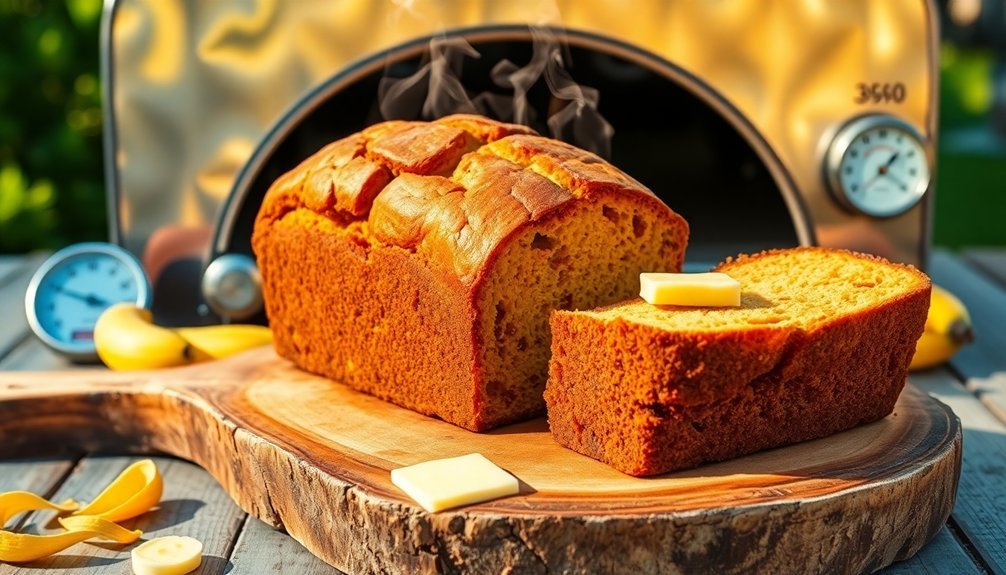
Why settle for traditional baking when you can harness the sun's power to create delicious and nutritious banana bread? Solar baking offers distinct advantages that'll transform your baking experience and enhance your results.
You'll preserve more nutrients in your banana bread through solar baking's lower cooking temperatures. The slow, gentle process maintains the natural flavors and vibrant colors of your ingredients while reducing nutrient degradation.
You're also getting superior taste and texture – expect a moist, tender crumb that melts in your mouth, thanks to the uniform heating that prevents overcooking or burning. Using metal canning jar rings helps elevate the bread pans for optimal heat distribution throughout the baking process.
The energy efficiency of solar baking means you'll save money on utility bills while helping the environment. You won't need electricity, gas, or firewood, and you can take your solar oven anywhere outdoors.
Plus, you're contributing to a healthier planet by choosing a smokeless cooking method that eliminates indoor air pollution.
Best of all, you're getting these benefits without compromising quality. In fact, side-by-side comparisons show that solar-baked banana bread often tastes better than its conventionally baked counterpart, making it a smart choice for both your health and taste buds.
Perfect Banana Selection
You'll want to look for bananas that have turned mostly brown or black, as these deliver the most intense flavor and natural sweetness for your sun-baked banana bread.
The ripening process transforms the banana's starches into sugars, creating that perfect balance of moisture and deep banana taste you're after.
Those dark spots on the peel aren't just cosmetic – they're actually signs that the fruit has developed the ideal sugar content and soft texture needed for superior banana bread. For quick ripening, place your bananas in a brown paper bag to naturally speed up the process.
Spotting Peak Ripeness Signs
Selecting perfectly ripe bananas for sun-cooked banana bread requires attention to three key indicators: appearance, aroma, and texture.
You'll want to look for bananas that display a medium-yellow color with a few brown spots, as these indicate ideal ripeness for baking. The peel should be easily removable but still maintain its structural integrity. These bananas will have an ideal high nutrient density that starts to decline in overripe fruit.
When you check the aroma, you'll notice a distinctly sweet smell that's noticeable but not overpowering. This is your signal that the sugars have developed properly. If there's no smell, the bananas aren't ready; if the smell is too strong, they're past their prime.
For texture, apply gentle pressure with your fingers. The perfect banana will yield slightly but won't feel mushy. It should feel heavy for its size, indicating good moisture content.
These perfectly ripe bananas offer the best balance of nutrients, with maximum levels of potassium and vitamin B6, while providing the right amount of natural sweetness for your bread. If you're seeing bananas that are very soft with extensive brown spotting, they're overripe and might make your bread too moist.
Natural Sweetness Development Process
Understanding how bananas develop their natural sweetness builds on our ability to spot peak ripeness. As your bananas ripen, they're undergoing a fascinating transformation where starches convert into natural sugars – primarily fructose, glucose, and sucrose. This process is driven by ethylene gas, a natural ripening hormone that your bananas produce.
| Stage | Starch Content | Sugar Level |
|---|---|---|
| Green | Highest | Lowest |
| Yellow | Medium | Medium |
| Brown-Spotted | Lowest | Highest |
You'll notice that as your bananas progress from green to yellow to brown, their sugar content nearly doubles. When you're selecting bananas for your sun-cooked banana bread, choose ones with brown spots for maximum sweetness – they're perfect for baking. You can even accelerate this natural sweetening process by placing your bananas in a paper bag with an apple or avocado, which increases ethylene gas production.
For the most delectable bread, consider freezing your overripe bananas first – this intensifies their natural sweetness. You can also enhance the sweetness by adding complementary spices like cinnamon or nutmeg, which create a harmonious flavor profile in your finished bread.
Brown Spots Mean Flavor
Banana-spotting mastery is essential for creating the perfect sun-cooked banana bread. When you're selecting bananas, look for ones with brown spots decorating their yellow peels – these spots are nature's way of telling you they're at peak ripeness for baking.
You'll want fruit that's soft but not mushy, maintaining enough structure that you'd still consider eating it plain.
These spotted bananas aren't just prettier – they're actually better for your bread. As bananas ripen, they develop a more intense flavor profile and increased moisture content, both vital elements for a rich, flavorful loaf.
You'll find they're easier to mash and incorporate into your batter, leading to a smoother final texture.
Don't make the mistake of using green bananas – they lack the necessary sweetness and moisture. Similarly, avoid completely black or rotten bananas that have gone too far.
The sweet spot is when your bananas are showing significant brown spots but haven't completely darkened. At this stage, they'll provide the perfect balance of moisture, natural sweetness, and that intense banana flavor that makes sun-cooked banana bread irresistible.
Essential Equipment Setup

Successful solar-baked banana bread requires precise equipment preparation before you begin.
You'll need to position your solar oven in direct sunlight and align it properly for maximum heat absorption. Place metal canning jar rings on the oven floor to elevate your bread pans, guaranteeing proper air circulation throughout the baking process.
Your choice of baking pan is vital for solar baking success. Select either a 5 x 9 inch loaf pan or two 4 x 8 inch pans for faster baking times.
You'll want to thoroughly oil your pan to prevent sticking, as proper preparation guarantees easy removal of your finished bread. Non-stick pans work particularly well for solar baking.
While preheating your solar oven, cover it with a clear plastic or glass lid to trap heat effectively.
You'll need to monitor the temperature and adjust the oven's position throughout the two-hour baking period. Position the oven rack about 6 inches from the heat source, and keep a thermometer handy to check that your bread reaches 200-205°F in the center.
Don't forget to tent the bread with aluminum foil during the final third of baking to prevent over-browning.
Preparing Your Ingredients
The key to exceptional sun-baked banana bread lies in carefully preparing and assembling your ingredients before any mixing begins.
You'll want to focus on selecting perfectly ripened bananas that are just slightly overripe – they'll provide ideal sweetness and flavor. If your bananas aren't quite ready, you can speed up the process using your sun oven for about 30 minutes.
Start by organizing your ingredients into two main groups: wet and dry. For the dry mixture, sift your all-purpose and whole-wheat flours together with the baking powder, baking soda, and spices.
Cut in the butter until you achieve a sandy texture that'll create a tender crumb in your finished bread.
Here are three critical steps for your wet ingredients:
- Mash your bananas thoroughly using a fork or potato masher until smooth.
- Combine eggs, yogurt, and vanilla extract with your mashed bananas.
- Add melted (but cooled) butter and your choice of plant-based milk or buttermilk.
When you're ready to combine everything, fold in any optional ingredients like toasted nuts or chocolate chips last, being careful not to overmix the batter.
The Science Behind Solar Baking
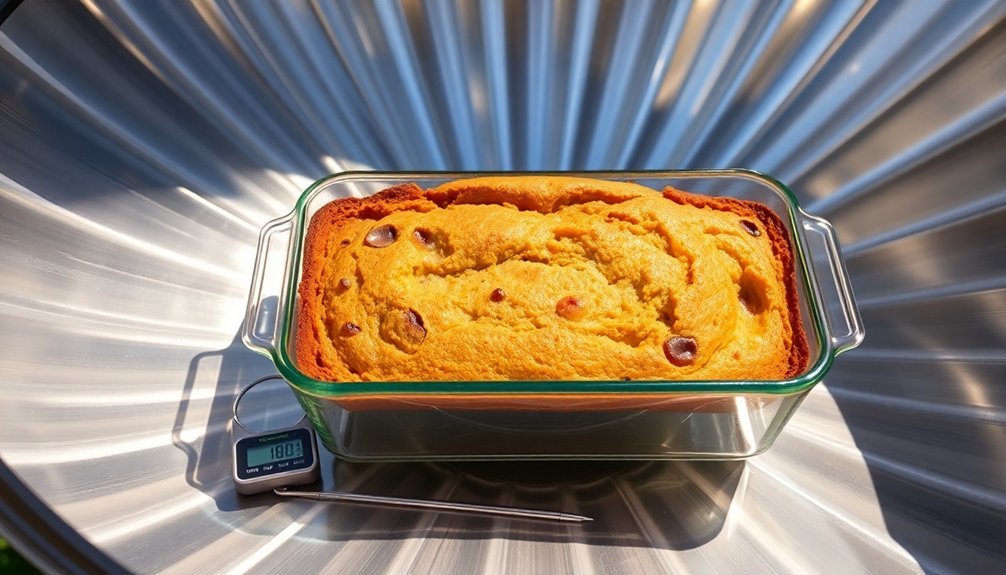
When you're baking banana bread in a solar oven, you'll need to understand how heat naturally flows and distributes through the enclosed space for best results.
You can control the temperature by adjusting your reflective panels and monitoring the trapped thermal energy through the glass or plastic covering.
The timing of your bake will depend on both the sun's intensity and how well you've positioned your solar oven to maximize heat collection and distribution.
Heat Distribution and Timing
Understanding solar baking requires knowledge of how heat moves through your solar oven and affects cooking times. When you're baking banana bread in a solar oven, heat distribution happens through a combination of reflection and absorption. The aluminum foil reflects sunlight onto your baking container, while dark-colored materials inside absorb and retain that heat.
You'll need to maintain temperatures between 125°F and 200°F for successful baking.
For ideal heat distribution and timing in your solar banana bread:
- Pre-heat your oven for up to an hour in direct sunlight, which can greatly reduce your overall baking time.
- Position metal canning jar rings under your baking pan to improve airflow and guarantee even heat distribution.
- Rotate your banana bread pan every 10-15 minutes to prevent hot spots and guarantee uniform baking.
You'll need about two hours to fully bake your banana bread, assuming consistent sunlight. Remember to check your oven's alignment with the sun periodically and adjust the reflective flap as needed.
Proper insulation using materials like newspaper or polystyrene will help maintain steady temperatures throughout the baking process.
Natural Energy Flow Patterns
Mastering solar baking starts with knowing how energy naturally flows through your solar oven. When you're baking banana bread, solar radiation enters through the transparent cover and gets trapped inside, creating a greenhouse effect that's essential for maintaining consistent temperatures.
You'll notice that darker surfaces, like black paper beneath your baking pan, absorb this radiation and convert it into heat more effectively.
As heat builds up, it moves through your solar oven in predictable patterns. The warm air naturally rises through convection, while cooler air sinks, creating a continuous circulation that helps bake your bread evenly.
Meanwhile, heat transfers directly from your pan to the banana bread through conduction. You'll maximize these natural flows by positioning your reflectors at ideal angles to direct more sunlight into the oven.
Your solar oven's design works with these energy patterns. The insulation keeps heat from escaping, while the greenhouse effect lets sunlight in but prevents infrared radiation from leaving.
This trapped energy steadily heats your banana bread to temperatures between 160-300°F, depending on your oven type, making it possible to bake perfectly without fossil fuels.
Temperature Control Methods
Along with proper sun alignment, successful temperature control in solar baking depends on four key elements: positioning, insulation, cookware selection, and active monitoring.
You'll need to adjust your solar oven every 30-45 minutes to track the sun's movement and maintain steady temperatures between 150-225°F – essential for achieving that perfect banana bread texture.
Your choice of cookware plays an important role in temperature management. Dark, thin-metal pans with tight-fitting lids will absorb and retain heat most effectively, while shiny surfaces can reflect precious heat away from your baking.
Proper insulation around the cooking cavity, using materials like crumpled newspaper or spun fiberglass, creates a stable thermal environment.
For precise temperature control, you'll want to:
- Use a reliable thermometer or Type-K thermocouple to monitor internal temperatures
- Position your oven in a wind-protected area and adjust the angle as needed
- Fine-tune temperatures by opening the latch or adjusting reflective panels when needed
Remember to preheat both the oven and cookware before adding your banana bread batter – this guarantees more consistent baking temperatures throughout the process.
Mastering Solar Oven Temperature Control
When baking banana bread in a solar oven, maintaining consistent temperatures between 150-225°F is crucial for success. You'll need to monitor your oven's temperature carefully using a reliable thermometer or Type-K thermocouple for precise readings. Start by preheating your solar oven for at least 20 minutes while you're preparing your ingredients.
| Temperature Control Action | Expected Result |
|---|---|
| Position oven facing sun | Maximizes heat collection |
| Adjust every 30-45 mins | Maintains steady temp |
| Use reflective panels | Increases heat capture |
To maintain ideal temperature, you'll need to reposition your oven every 30-45 minutes to follow the sun's movement. If temperatures climb too high, you can adjust the oven's position to reduce direct sunlight exposure. Choose a sheltered spot to prevent wind interference, which can affect temperature stability.
For consistent heat retention, use dark-colored, lidded cookware and verify your glazing material is securely attached. You can enhance insulation by surrounding the cooking cavity with multiple layers of crumpled newspaper or spun fiberglass. Deploy reflective panels strategically to direct additional sunlight onto the cooking surface when needed.
Achieving Perfect Texture

The perfect texture in solar-baked banana bread starts with your choice of bananas and careful attention to ingredient ratios. You'll want overripe bananas with plenty of brown spots, as they're naturally moister and easier to mash. Before mixing your batter, verify you've thoroughly mashed these bananas to distribute moisture evenly throughout your bread.
Your batter's consistency should mirror slow-moving honey, coating the back of a spoon while leaving a visible trail. To achieve this ideal texture in your sun-cooked creation, you'll need to:
- Bring all ingredients to room temperature, especially eggs and butter, for smoother incorporation.
- Adjust your wet-to-dry ratio based on banana moisture content and any additional mix-ins.
- Mix ingredients just until combined to avoid developing tough gluten strands.
When adding extras like chocolate chips or nuts, remember they'll slightly thicken your batter. You'll want to reduce dry ingredients accordingly to maintain the perfect balance.
If your bananas are particularly mushy, compensate by slightly decreasing other wet ingredients. This attention to detail guarantees your solar-baked banana bread achieves that coveted moist-yet-structured texture that makes it irresistible.
Time and Patience Matter
Throughout the sun-baking process, patience becomes your greatest ally in crafting the perfect banana bread. You'll need to start by letting your batter rest for an hour at room temperature, which allows the ingredients to meld together properly and helps the flour absorb the liquid components. This vital step enhances both flavor development and guarantees you won't encounter unmixed pockets in your final loaf.
As you monitor the baking process, you'll want to check your bread's progress frequently, especially during the final stages. While traditional ovens bake at 350°F, sun-baking requires careful attention to temperature fluctuations throughout the day. You can use a thermometer to verify when your bread reaches the ideal internal temperature of 200-205°F.
If you notice the top browning too quickly, don't hesitate to tent it with aluminum foil. Once baked, resist the urge to slice immediately – letting your bread cool completely will improve its texture and flavor profile. In fact, if you can wait until the next day, you'll be rewarded with even better results as the flavors continue to develop and intensify.
Tips for Consistent Results
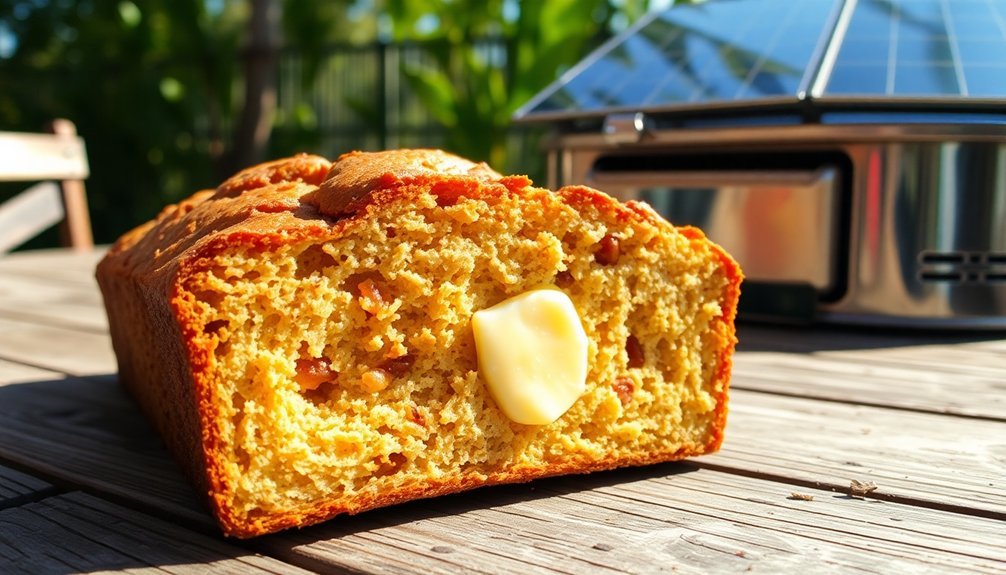
Mastering sun-cooked banana bread requires more than just patience – it demands attention to detail and consistent techniques.
You'll need to focus on precise measurements and high-quality ingredients to achieve that perfect loaf. Using overripe bananas guarantees ideal sweetness, while carefully weighing your ingredients assures the right consistency every time.
Your mixing technique plays a vital role in the bread's final texture. Remember to combine wet and dry ingredients separately before folding them together gently by hand – skip the electric mixer to prevent dense, tough bread.
When you're ready to bake, make sure your Sun Oven is properly preheated and positioned.
Here are three key indicators that your bread is perfectly done:
- A toothpick inserted in multiple spots comes out clean or with just a few dry crumbs
- The crust has developed a golden-brown color
- The bread feels firm but springy when gently pressed
Let your bread cool in the pan for a few minutes before transferring it to a wire rack.
This cooling period is essential for achieving the right texture and preventing a gummy consistency.
Frequently Asked Questions
Can I Substitute Honey for Sugar in Sun-Baked Banana Bread?
Yes, you can substitute honey for sugar in sun-baked banana bread. Just reduce the honey amount by 1/4, lower your solar oven temperature, adjust liquid ingredients, and add a pinch of baking soda for proper rising.
How Do Cloudy Days Affect the Flavor of Solar-Baked Banana Bread?
You won't notice much difference in flavor on cloudy days, though your bread will take longer to bake. The clouds mainly affect cooking time and temperature, not the taste of your banana bread ingredients.
Does Altitude Impact Solar Baking Time for Banana Bread?
Yes, at higher altitudes you'll need to adjust your solar baking time. Since air pressure's lower and liquids evaporate faster, you should extend your baking time and add extra moisture to your banana bread.
Can I Use Frozen Bananas for Solar-Baked Banana Bread?
Yes, you can use frozen bananas in your solar-baked banana bread. They'll make your bread extra moist and flavorful since freezing concentrates their sweetness. Just thaw and drain them before mixing into your batter.
What's the Shelf Life of Sun-Baked Banana Bread Compared to Oven-Baked?
You'll find sun-baked banana bread's shelf life is similar to oven-baked: 2-3 days at room temperature, up to a week refrigerated, and 3 months frozen. Just be sure to wrap it properly for storage.
In Summary
You'll find sun-cooked banana bread's irresistible charm comes from its slow, gentle baking process that perfectly caramelizes the natural sugars while preserving the bananas' moisture. With proper equipment setup, temperature control, and patience, you're creating something truly special. Whether you're an eco-conscious baker or solar cooking enthusiast, this method delivers uniquely flavorful results that'll make you rethink traditional baking approaches.


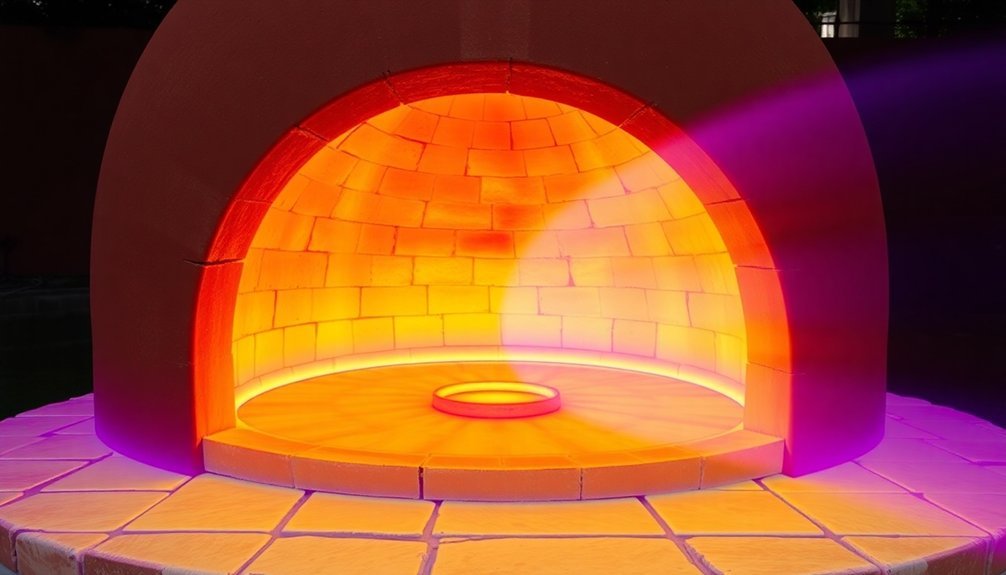

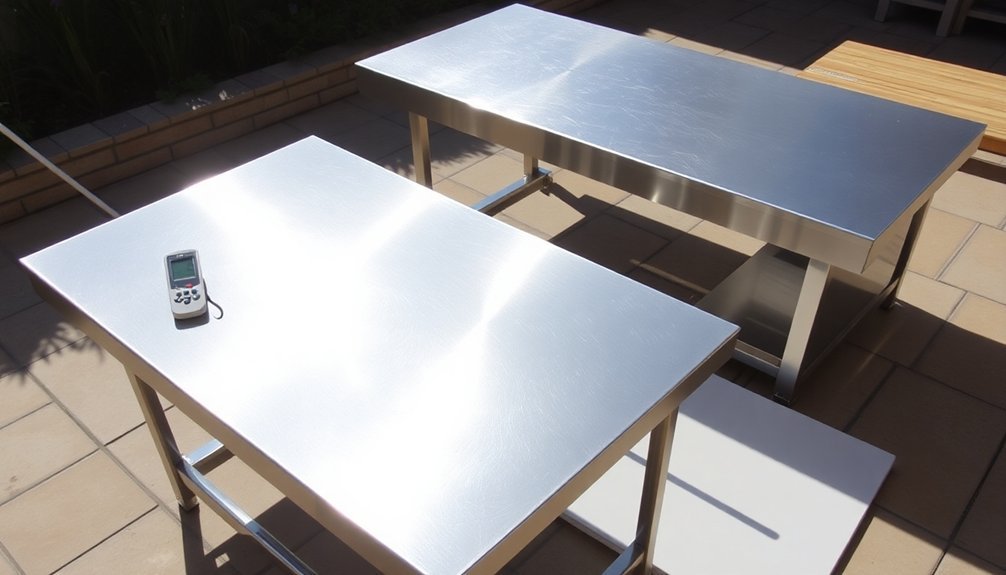
Leave a Reply